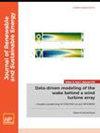Assessing rural energy poverty and early warning based on long-run evolution for clean energy transition in China
IF 1.9
4区 工程技术
Q4 ENERGY & FUELS
引用次数: 0
Abstract
Rural China grapples with pervasive energy poverty. This study aims to measure China's rural energy poverty and propose early warning strategies. It establishes a rural energy relative poverty evaluation system based on four dimensions: energy service effectiveness, consumption cleanliness, management integrity, and development sustainability. Using the Analytic Hierarchy Process-Criteria Importance Though Intercriteria Correlation-Technique for Order Preference by Similarity to Ideal Solution model, it calculates rural energy poverty indices for Chinese provinces, while ward cluster analysis sets regional and hierarchical early warning criteria. Findings indicate: (1) China's rural energy poverty index varies widely, with a low range of 0.49–0.52 and a high range above 0.65. The top 14 regions average a rural energy poverty index of 0.62. (2) Over 2015–2021, there is a 9.70% decrease in the index, indicating a general downward trend. While rural energy services' efficiency and management integrity improve, consumption cleanliness and development sustainability decline. (3) Spatially, energy poverty is higher in the west and north, notably lower in the east and south. The eastern coastal and central regions exhibit significantly lower poverty levels due to better economic foundations and leading energy transformations. (4) Nine provinces are red warning areas, witnessing declining sustainability but improving service effectiveness, consumption cleanliness, and management integrity. Weak links in energy poverty vary across regions in terms of service effectiveness, consumption cleanliness, management integrity, and development sustainability. This study enhances the rural energy poverty evaluation system and proposes regional, hierarchical, and phased early warning standards.基于长期演化的中国农村能源贫困评估与清洁能源转型预警
中国农村普遍存在能源贫困问题。本研究旨在衡量中国农村能源贫困状况,并提出预警策略。它从能源服务有效性、消费清洁性、管理完整性和发展可持续性四个维度建立了农村能源相对贫困评价体系。利用层次分析法--标准重要性--标准间相关性--与理想解相似性排序偏好技术模型,计算了中国各省的农村能源贫困指数,并通过病房聚类分析设定了区域性和层次性预警标准。研究结果表明:(1) 中国农村能源贫困指数差异较大,低的在 0.49-0.52 之间,高的在 0.65 以上。前 14 个地区的平均农村能源贫困指数为 0.62。(2)2015-2021 年,该指数下降了 9.70%,表明总体呈下降趋势。在农村能源服务效率和管理诚信度提高的同时,消费清洁度和发展可持续性下降。(3)从空间上看,西部和北部的能源贫困程度较高,东部和南部明显较低。东部沿海和中部地区由于经济基础较好,能源转型领先,贫困程度明显降低。(4)九个省份为红色预警地区,可持续发展能力下降,但服务效率、消费清洁度和管理诚信度有所提高。各地区能源贫困的薄弱环节在服务效率、消费清洁度、管理诚信度和发展可持续性方面存在差异。本研究完善了农村能源贫困评价体系,提出了区域性、分层次、分阶段的预警标准。
本文章由计算机程序翻译,如有差异,请以英文原文为准。
求助全文
约1分钟内获得全文
求助全文
来源期刊

Journal of Renewable and Sustainable Energy
ENERGY & FUELS-ENERGY & FUELS
CiteScore
4.30
自引率
12.00%
发文量
122
审稿时长
4.2 months
期刊介绍:
The Journal of Renewable and Sustainable Energy (JRSE) is an interdisciplinary, peer-reviewed journal covering all areas of renewable and sustainable energy relevant to the physical science and engineering communities. The interdisciplinary approach of the publication ensures that the editors draw from researchers worldwide in a diverse range of fields.
Topics covered include:
Renewable energy economics and policy
Renewable energy resource assessment
Solar energy: photovoltaics, solar thermal energy, solar energy for fuels
Wind energy: wind farms, rotors and blades, on- and offshore wind conditions, aerodynamics, fluid dynamics
Bioenergy: biofuels, biomass conversion, artificial photosynthesis
Distributed energy generation: rooftop PV, distributed fuel cells, distributed wind, micro-hydrogen power generation
Power distribution & systems modeling: power electronics and controls, smart grid
Energy efficient buildings: smart windows, PV, wind, power management
Energy conversion: flexoelectric, piezoelectric, thermoelectric, other technologies
Energy storage: batteries, supercapacitors, hydrogen storage, other fuels
Fuel cells: proton exchange membrane cells, solid oxide cells, hybrid fuel cells, other
Marine and hydroelectric energy: dams, tides, waves, other
Transportation: alternative vehicle technologies, plug-in technologies, other
Geothermal energy
 求助内容:
求助内容: 应助结果提醒方式:
应助结果提醒方式:


